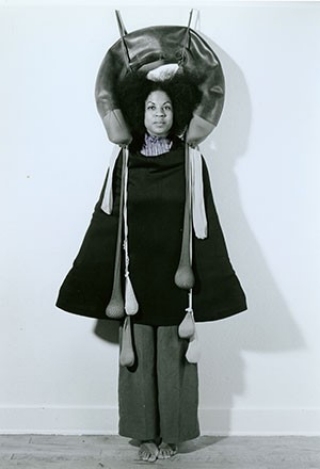Born 1943, Chicago, Illinois
While a graduate student at California State University in Los Angeles in the late 1960s, Senga Nengudi navigated between the Watts Towers Art Center (where she volunteered in the experimental community-based educational programs espousing an African American aesthetic) and the more mainstream avant-gardism of the Pasadena Museum of Art (where she worked as a teaching assistant). Trained in art and dance, Nengudi had traveled to Tokyo in 1966–1967, seeking out the multidisciplinary Gutai group and Eastern traditions of ritualized movement, which in turn kindled her interest in African rites. Born Sue Irons, the artist adopted her African name in 1974, the year she saw African Art in Motion: Icon and Act, the seminal exhibition at UCLA’s Wight Gallery that interpreted African art history as “a history of a danced art,” which its curator, Robert Farris Thompson, defined as “the blending of movement and sculpture, textiles, and other forms.”
In 1975 Nengudi began her long-running RSVP series, with free-form sculptures made from nylon mesh—stretched, knotted, and tacked to gallery walls—their dangling, bulbous appendages filled with sand. Recalling her experience of childbirth, Nengudi chose worn pantyhose as a material because of its low cost, because it was evocative of the body’s elasticity under stress, and not least because the black female body has historically been a vehicle in service to others. The series title, “please respond,” alludes to the participatory call and response form of African American music—evoked in Swing Low, with its association to gospels, but often enacted literally. Presented in gallery contexts, many of these works functioned not only as aesthetic objects but as performance props, which were activated, sometimes by longtime collaborator Maren Hassinger, using stylized motions, captured in series of photographs, that are redolent of African ceremony, Japanese Kabuki theater, and contemporary dance.
Lauren Schell Dickens
Odita, O. Donald. “The Unseen, Inside Out: The Life and Art of Senga Nengudi.” Nka: Journal of Contemporary African Art, nos. 6–7 (Summer–Fall 1997): 24–27.
Yasar, Begum. Senga Nengudi. New York: Dominique Lévy Gallery, 2015.
